
Skinks are lizards belonging to the family Scincidae, a family in the infraorder Scincomorpha. With more than 1,500 described species, the family Scincidae is one of the most diverse families of lizards.

Cryptoblepharus is a genus of skinks

Ctenotus is a genus of skinks. The genus belongs to a clade in the Sphenomorphus group which contains such genera as Anomalopus and the close relatives Eulamprus and Gnypetoscincus.
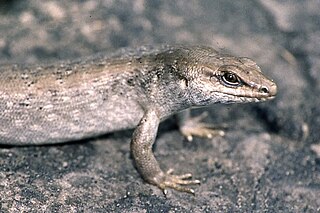
Leiolopisma is a genus of skinks. Most species occur in the region of New Caledonia-New Zealand, and they are related to other genera from that general area, such as Emoia; these and others form the Eugongylus group. One living and two extinct taxa represent a clade endemic to the Mascarenes.(Austin & Arnold 2006)

Mabuya is a genus of long-tailed skinks restricted to species from various Caribbean islands. They are primarily carnivorous, though many are omnivorous. The genus is viviparous, having a highly evolved placenta that resembles that of eutherian mammals. Formerly, many Old World species were placed here, as Mabuya was a kind of "wastebasket taxon". These Old World species are now placed in the genera Chioninia, Eutropis, and Trachylepis. Under the older classification, the New World species were referred to as "American mabuyas", and now include the genera Alinea, Aspronema, Brasiliscincus, Capitellum, Maracaiba, Marisora, Varzea, and Copeoglossum.

Megalomys luciae, also known as the Saint Lucia pilorie or Saint Lucia giant rice rat, as well as several variant spellings, is an extinct rodent that lived on the island of Saint Lucia in the eastern Caribbean. It was the size of a small cat, and it had a darker belly than Megalomys desmarestii, a closely related species from Martinique, and slender claws. The last known specimen died in the London Zoo in 1852, after three years of captivity. It probably became extinct in the latter half of the 19th century, with the last record dating from 1881. There is a stuffed specimen in the collection of the Natural History Museum in London.
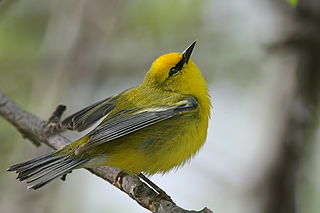
Vermivora is a genus of New World warblers.
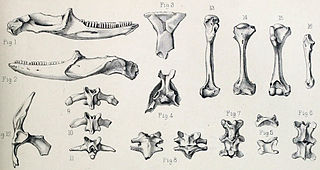
Leiolopisma mauritiana, Didosaurus maurtianus, is a large, extinct species of skink. It was found only in Mauritius, but became extinct around 1600 probably due to introduced predators.
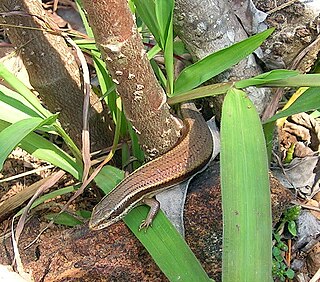
Lygosominae is the largest subfamily of skinks in the family Scincidae. The subfamily can be divided into a number of genus groups. If the rarely used taxonomic rank of infrafamily is employed, the genus groups would be designated as such, but such a move would require a formal description according to the ICZN standards.

The terror skink, also called Bocourt's terrific skink or Bocourt's eyelid skink, is a species of skink endemic to the Île des Pins, a small islet off the coast of New Caledonia. First described in 1876, it was presumed to be extinct, but was rediscovered in 1993, and since then several individuals have been seen. Because of its small area of occupation and small population size, the International Union for Conservation of Nature has assessed its conservation status as being "endangered".
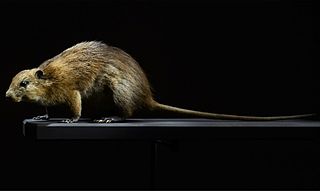
Megalomys is a genus of rodent in the family Cricetidae, part of the tribe Oryzomyini. The genus contains five large rodents from various Caribbean islands, of which two are known to have survived into modern times, but all of which are now extinct. The last species to survive was M. desmarestii from Martinique, which became extinct after the Mount Pelée eruption in 1902. Ancient DNA analysis places Megalomys forming a clade with Pennatomys, sister to the clade containing Aegialomys, Nesoryzomys, Melanomys and Sigmodontomys, having diverged from the mainland clade around 7 million years ago.
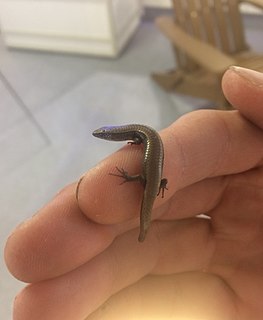
Spondylurus is a genus of lizards in the family Scincidae. The genus Spondylurus, vernacularly known as the Antillean four-lined skinks, is a neotropical skink taxon including many species.

The spotfin killifish is a member of the genus Fundulus. This hardy fish is notable for spending its entire life in sporadically flooded salt marsh habitat, sheltering in shallow pools, puddles, and small tidal rivulets. It closely resembles the mummichog in shape and coloration, but the two species can be distinguished by dorsal fin ray count: 8–9 in the spotfin versus 11–12 in the mummichog. Additionally, the dorsal fin of F. luciae originates farther back, and slightly behind the anal fin origin; in the mummichog, the dorsal fin begins anteriorly to the anal fin origin. The spotfin killifish is named for the pronounced ocellus found on the posterior dorsal fin of adult males. It is a small fish, seldom attaining 50 mm in total length. Its distribution extends along the U.S. east coast from Massachusetts to Georgia.
Capitellum is a genus of skinks. Species were previously placed in the genus Mabuya. All species in this genius are considered possibly extinct, due to a lack of recent sightings but the presence of potential refuges.
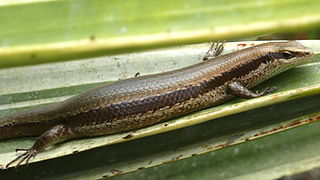
Copeoglossum is a genus of skinks. They were previously placed in the genus Mabuya.
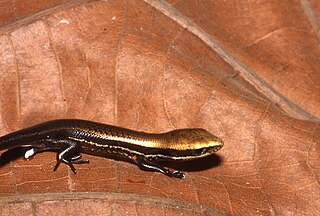
Varzea is a genus of skinks.

Mabuyinae is a subfamily of skinks within the family Scincidae. The genera in this subfamily were previously found to belong the Mabuya group in the large subfamily Lygosominae.
The Barbados skink is a species of skink found in Barbados.
The Saint Lucia skink was a species of skink found in Saint Lucia. It is now considered extinct.















